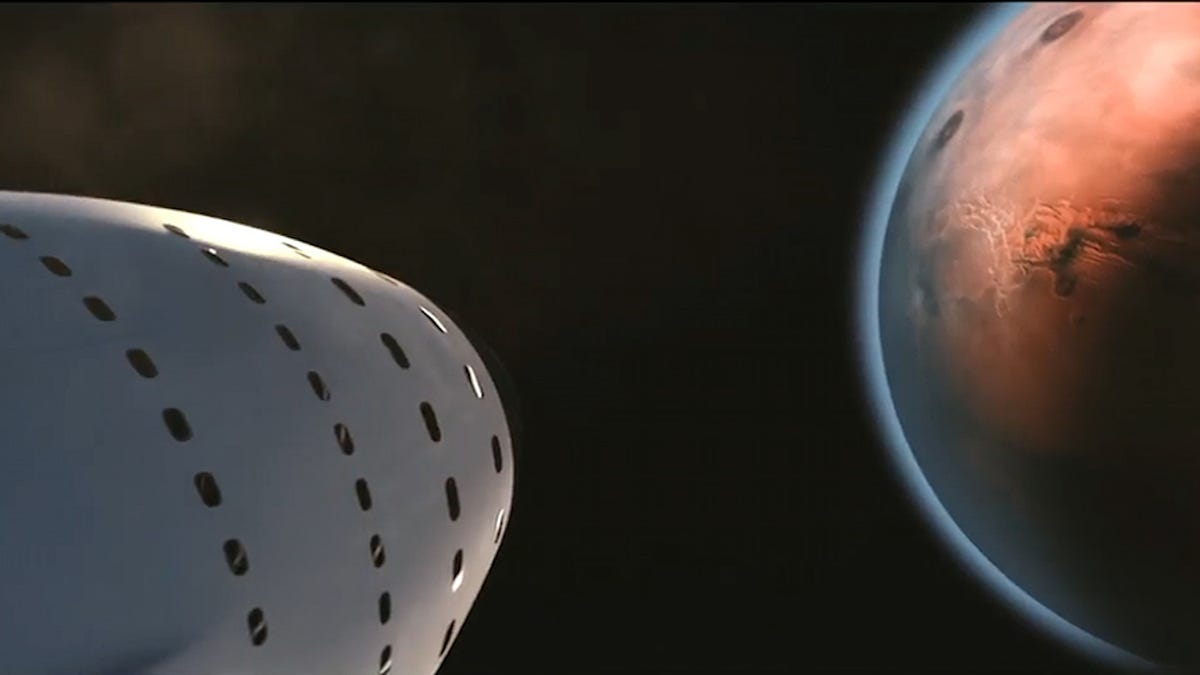SpaceX reveals where the first people it sends to Mars will live
It might be a little cramped.

The first Mars residents could live out of their ship.
SpaceX and its founder, Elon Musk, have been telling us about their audacious plan to build a city on Mars for a few years now. But so far the plan has been short on details of how such a Martian metropolis might be set up.
SpaceX's Paul Wooster, principal Mars development engineer, provided a few tidbits Friday on where the first people SpaceX sends to Mars will actually live.
The SpaceX plan calls for an unmanned, robotic mission to Mars as soon as 2022, followed by the first human flight to the red planet a few years later. It's been a little unclear whether robots would set up a habitat for the first people to arrive or if those initial Martian visitors would become the planet's first construction workers.
Speaking at the 21st annual Mars Society Convention in Pasadena, California, Wooster reiterated what Musk has said in the past, noting that building up a presence on the surface of Mars is "something where a lot of people beyond SpaceX can really contribute."
But Wooster went on to clarify that initial Mars operations will probably be based out of the landed SpaceX "BFR" spacecraft on the surface.
"Early on, they're very valuable on the surface of Mars. You'd actually be having most of the ships stay and you'd be operating using the various systems on them to support the activities there," he told the crowd. "Very much early on they'd be sitting there indefinitely."
Wooster says the first BFR spacecraft sent to Mars would stay there until they became more valuable as a needed means of transportation than as a support system on the surface. He says the first people on Mars would probably live out of BFR while building habitation, landing pads and other infrastructure.
Musk presented his Mars plan initially at the International Astronautical Congress in Mexico in 2016 and gave an update at the same annual meeting a year later. Both times he focused almost entirely on SpaceX plans to provide transportation to Mars via BFR, without saying too much about what happens after landing and who will actually build needed infrastructure on the Martian surface.
Wooster also reiterated Musk's initial ambitious vision to build not just a small base on Mars like what currently exists on Antarctica, but to expand from such an outpost to create a full-fledged town and eventually multiple major cities on our neighboring planet.
The key to making Mars an actual destination, according to Wooster, lies in the massive capacity of the planned spacecraft. He says it'll be able to deliver "100 tons (90,719 kg) of useful payload to the surface of Mars."
By comparison, the Curiosity rover NASA sent to Mars weighs just about 1 percent of that amount.
All these plans currently rest on a rocket that has yet to fly, but SpaceX is now ramping up development. Musk and Wooster hope BFR will follow in the footsteps of its predecessor, the Falcon Heavy, with one spectacular successful test launch under its belt so far.
Crowd Control: A crowdsourced science fiction novel written by CNET readers.
Solving for XX: The tech industry seeks to overcome outdated ideas about "women in tech."

